A colorimeter is a photoelectric colorimeter based on CIE standard colorimetry. It is a tool that simulates the way the human eye sees colors. Its measurement angle of view is consistent with the angle of view of the human eye observing objects. Therefore, the CIE standard colorimetry system has made corresponding provisions for the observer angle of the colorimeter . This article introduces the colorimeter standard colorimetry system and the observer angle 2°/10°.
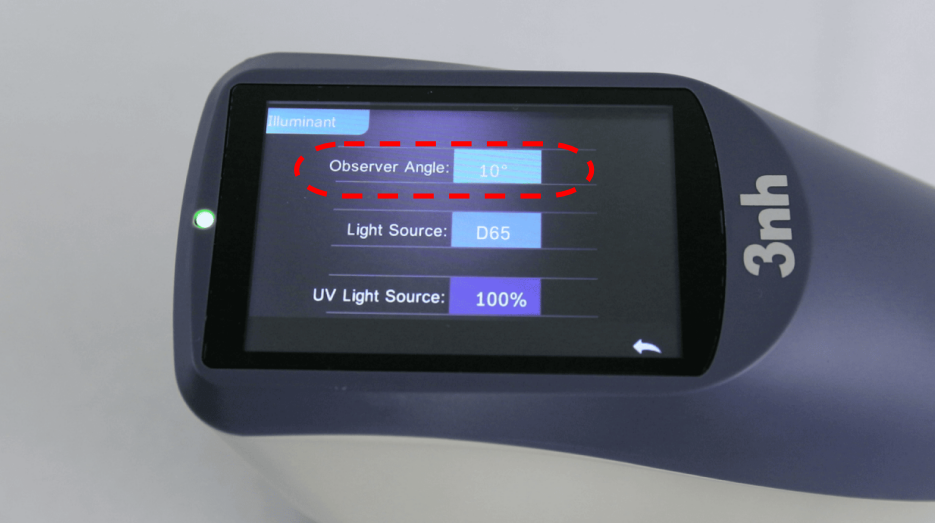
In the field of color measurement, the observer angle is one of the key factors affecting color perception. The observer angles of 2° and 10° fields of view correspond to different color observation conditions and application scenarios.
1. 2° Field of View - Suitable for Small Area Measurement
The concept of the 2° standard observer originated in 1931, based on a set of color matching functions of standard observers. These functions were obtained by statistical analysis of the data of normal color vision observers and are closely related to the structure of the human eye. The CIE1931-XYZ color space is based on the central observation conditions of the 2° field of view, which mainly involves the foveal cone cells of the human eye. This field of view is suitable for an observation range of 10-4°, but for extremely small fields of view less than 1° or fields of view greater than 40°, the CIE1931-XYZ standard observer is no longer applicable.
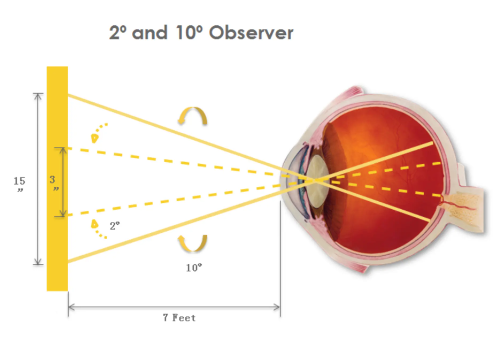
Applicable to Scenes with a 2° Field of View
① Accurate color detection: such as printed materials, inks, small color blocks (such as electronic component logos), jewelry color evaluation, etc.
② High-precision matching requirements: laboratory environment, standard color card calibration (such as Pantone color card uses 2° by default)
③ Historical standard: Traditional industries (such as publishing and printing) have long used 2°, which is more compatible with early instruments.
2. 10° Field of View - Suitable for Large Area Measurement
In order to adapt to the needs of a wider field of view, a 10° standard observer was developed in 1964 based on the 2° observer. The 10° observer has a broader statistical basis because it is built based on the data of more normal color vision observers. The CIE1964-XYZ color system takes into account a larger field of view, covering the cone cells in the center of the retina and the surrounding rod cells, which is suitable for color observation with a 10° field of view. Under the condition of a 2° field of view, the human eye's ability to recognize the color of an object is relatively low, while under the condition of a 10° field of view, the accuracy and reproducibility of color judgment are higher. Therefore, most current color measurements use a 10° field of view.
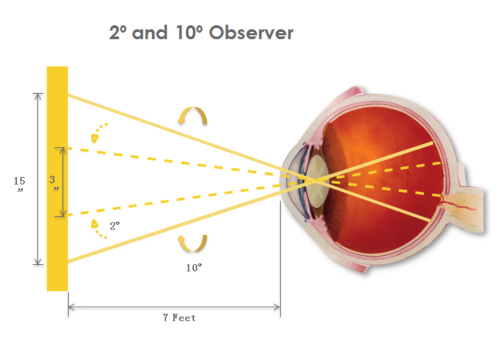
Applicable to scenes with a 10° field of view:
① Large sample or overall color evaluation: such as large area color measurement of textiles, plastic sheets, automotive interiors, wall coatings, etc.
② Daily observation simulation: Need to simulate the natural observation of human eyes (such as product display, furniture color matching)
③ Uneven surface color: samples with uneven color distribution (such as textured leather, gradient materials) are closer to actual perception.
3. How to Choose a Colorimeter with a 2°/10° Field of View
a. 2° field of view: high precision, small field of view, traditional industry, fine color difference analysis
b.10° field of view: wide field of view, daily perception, large sample, overall color consistency evaluation
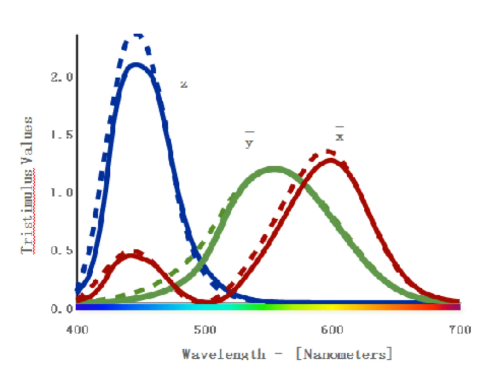
The response curve is different, and the chromaticity difference is slightly different
4. Common Misunderstandings about the Field of View of Colorimeter and Selection Suggestions
a. Practical Selection Suggestions:
①Modern Trends:
The 10° field of view is closer to actual observation scenarios, and its application scope is gradually expanding, but traditional industries still rely on 2°.
When making a selection, it is recommended to focus on the actual usage scenario of the sample and make a comprehensive decision based on industry standards and equipment compatibility.
②Follow Industry Standards:
Printing/electronics industry: 2° is often used (e.g. ISO13655 stipulates that 2° is used for printing measurement)
Textile/Automotive Industry: Tend to 10° (e.g. AATCC standard recommends 10° for textiles)
③ Sample Size Determination:
If the sample area is smaller than the measurement aperture, 2° is preferred; if the entire field of view is covered, 10° is preferred
All measurements of the same project must have the same field of view, otherwise the data cannot be directly compared
b. Common Misunderstandings:
① The larger the field of view, the higher the accuracy: Wrong. The field of view selection has nothing to do with accuracy, but matches the human eye's perception of the scene.
② 10° is suitable for all large samples: it needs to be combined with the uniformity of the sample. If the color is uniform, 2° may be more accurate; if the overall situation needs to be comprehensive, choose 10°
③ Only pay attention to the field of view and ignore the light source: the light source type (such as D65, A light source) and the field of view jointly affect the results and need to be standardized
Recommended Measurement Software and Several Measuring Instruments
Under the condition of d/8 geometric optical illumination recommended by CIE, TS7700 grating spectrophotometer can accurately measure the SCI and SCE reflectance data of samples / fluorescent samples, and also can accurately measure and express various color difference formulas and color indexes in various color spaces. With spectrophotometer TS7700, it can easily realize the accurate transmission of color and can also be used as the detection equipment of accurate color matching system.
Benchtop Spectrophotometer TS8560
TS8560 is a benchtop grating spectrophotometer which is developed by 3nh independently with core technology. It uses a dual-array CMOS image sensor to have high sensitivity and a wider spectral response range, which makes the test more accurate. With a 10.5-inch independent rotating screen, it is convenient and easy to use. TS8560 also supports Xenon pulse and LED two Light Sources. The repeatability of ΔE*ab is within 0.01, and inter-instrument error is within 0.1, and the measurement performance is super stable and accurate.








 0086 18165740359
0086 18165740359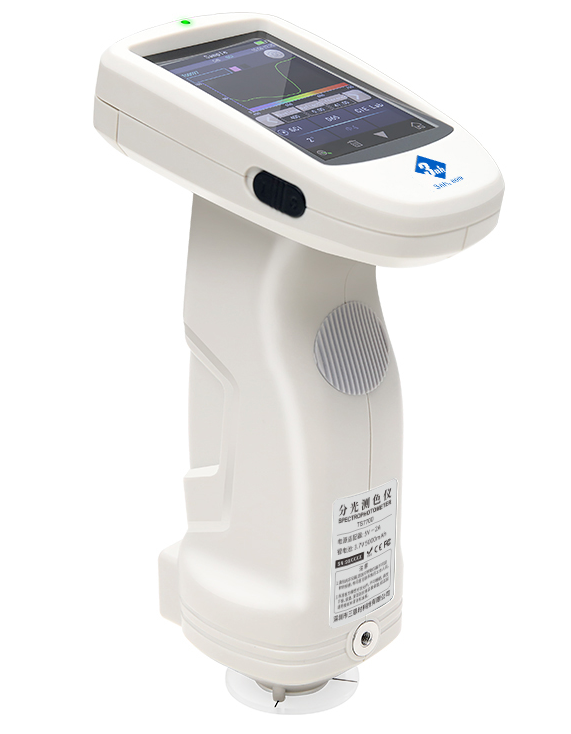
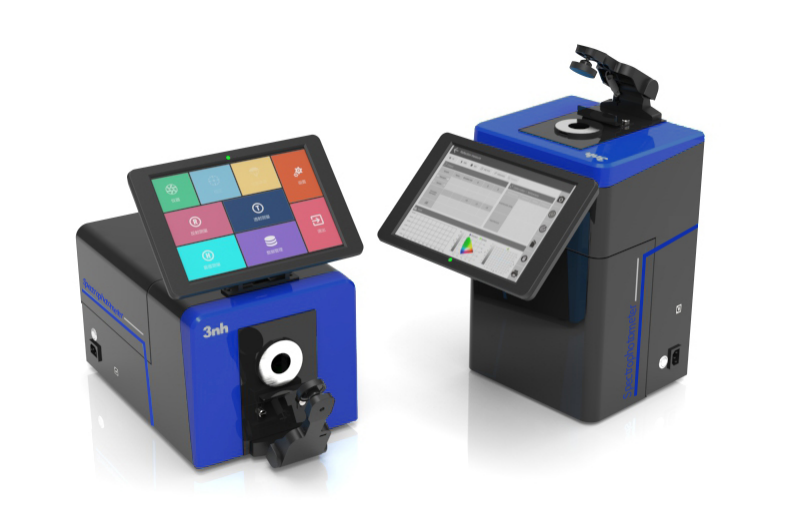
 Skype Online
Skype Online